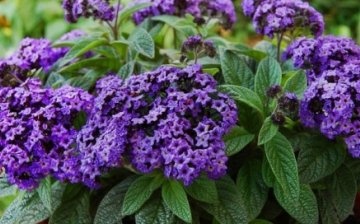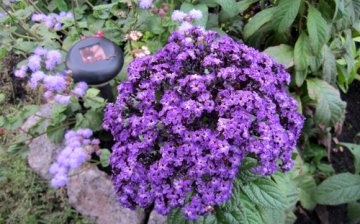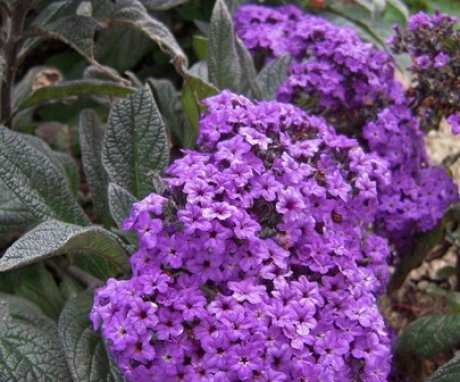Growing heliotrope from seeds
Heliotrope is admired by most gardeners. This semi-shrub (its height is 40-50 centimeters) with wrinkled, pubescent leaves of an ovoid shape blooms with bright purple flowers, collected in corymbose inflorescences, moreover, with a pleasant floral-vanilla aroma. Recently, breeders have developed varieties with white, pink and blue flowers. It blooms from early summer until the first frost.
Content:
- Unique properties of heliotrope
- Reproduction of heliotrope and sowing seeds
- Seedling care
- Pests
- Summer heliotrope care
- Winter heliotrope care
Unique properties of heliotrope
According to legend heliotrope possesses miraculous magical properties. He is able to endow his master with good luck in all matters, help him find harmony with himself, with people and with nature. They say that he protects the house from evil spirits and robberies.
Heliotrope flowers are rich in essential oil that is used to make perfumes.
Peruvian sunflower - this is often called heliotrope because, like a sunflower, it turns its flowers after the sun. The name heliotrope also speaks of this property. Translated from the Greek "helios" is the sun, and "tropos" is the turn.
Reproduction of heliotrope and sowing seeds
Heliotrope is a perennial, but in Russia it is grown as an annual: a thermophilic plant cannot survive a harsh winter. The flower propagates well by cuttings and dividing the bush, but if there is nowhere to get the cuttings, buy seeds.
Growing heliotrope from seeds is not as difficult as they write about it. The technology is about the same as when growing from petunia seeds. A mixture of earth with sand and peat in a ratio of 1: 1: 2 is steamed and poured into seedling boxes, then the soil is well watered. You can also use store-bought soil.
Sowing is done at the end of February. In the instructions, you can find advice not to sprinkle the seeds with soil so that they germinate better. But in reality, flower seeds germinate beautifully both in the light and in the dark. But it is better to cover the seeds with earth: this way they will dry out less.
The seeds are very small (1 gram contains up to one and a half thousand seeds), they can be mixed with sand so that the sowing is uniform, or you can put snow on the substrate, and then evenly spread the seeds on its surface with a toothpick. After that, the box is covered with glass or polyethylene, creating a mini-greenhouse. The snow will melt and the seeds will be on the surface of the earth.
Put the greenhouse on the window, maintaining the temperature + 18-20 degrees. As it dries, moisten the soil by spraying.
Seedling care
Seedlings will appear only after three to four weeks. The optimum temperature at this time is + 20-22 degrees.
After the emergence of shoots, the greenhouse must be ventilated and condensate removed so that the plants are not hit by the "black leg".
You can dive seedlings when they get stronger and give at least a couple of real leaves. Each seedling requires an individual pot with a diameter of 9 centimeters. The soil they need is fertile, with the addition of sand and good drainage.
After half a month after diving, feed the seedlings using any fertilizer for seedlings.
Pests
In addition to the "black leg", seedlings can be threatened pincers... Their appearance is evidenced by black spots on the leaves, drying of young shoots and leaf fall. Also, heliotropes can be affected by whiteflies, spider mites, aphids, gray rot, rust fungi.
Summer heliotrope care
Plant seedlings in open ground only after the night frosts cease to threaten the plants. For planting, choose a sunny place: with a lack of light, the leaves become faded. The soil should be loose, as waterlogging can lead to the death of the plant. When planting, add humus to each hole.
You can use containers or flowerpots for planting. In this case, plant the seedlings earlier: if necessary, you can bring the container into the house.
When planting in a flowerpot, other annuals are planted with the heliotrope. Heliotrope goes well with phlox... It looks beautiful against the background of yellow rudbeck and multi-colored pelargonium. The heliotrope is well combined with salvia, marigolds, petunia and roses.
Fertilization is necessary along with the soil. It is recommended to use fertilizer sticks or granular fertilizer: one dressing will be enough for the entire period of heliotrope growth.
Distribute the plants evenly over the flowerpot, stepping back 5 centimeters from its edge. Do not overdo it: if there are a lot of seedlings, they will lose their decorative appearance and stretch out. You can plant 8 plants in a flowerpot with a diameter of 40 centimeters: 3 heliotrope and 5 phlox.
The first time after planting, the seedlings should be shaded.
After planting in open ground, the plants do not require special care. They only need to be watered as the soil dries up and organic and mineral fertilizers applied 2 times a month. Heliotrope responds perfectly to Kemira Lux and Ideal.
Winter heliotrope care
For the winter, you can dig up the plant and plant it in a pot. Place the pot on a cool light window, keeping the temperature + 12-15 degrees.
Particular attention should be paid to soil moisture. If the water stagnates, the roots will start to rot. If the ground dries up, the leaves will begin to crumble. But spraying will not be superfluous.
As you can see, the cultivation of heliotrope from seeds is carried out in the same way as the cultivation of other plants with very small seeds, and does not cause any particular difficulties.
And in gratitude for your labors, heliotrope will delight you with a beautiful and lush flowering and fill your garden with a pleasant aroma.













